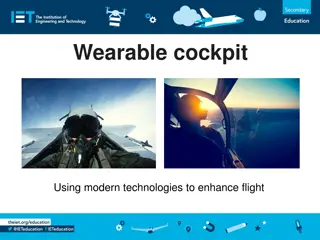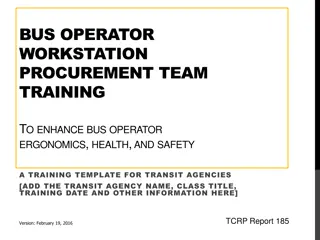Understanding Anthropometrics and Ergonomics in Design
Explore the principles, applications, and design influence of anthropometrics and ergonomics. Learn how data shapes our environment and enhances product quality. Discover the significance of anthropometric data and ergonomics in design, and engage in hands-on tasks to apply these concepts practically. Understand why getting ergonomics right is crucial in product design. Utilize modeling techniques and annotation methods to optimize product fit and usability.
Download Presentation

Please find below an Image/Link to download the presentation.
The content on the website is provided AS IS for your information and personal use only. It may not be sold, licensed, or shared on other websites without obtaining consent from the author. Download presentation by click this link. If you encounter any issues during the download, it is possible that the publisher has removed the file from their server.
E N D
Presentation Transcript
Mr Murray Todays Lesson; Principles, applications and the influence on design of anthropometrics and ergonomics What will you Learn? You will learn how we shape our built environment and how we use data to improve the quality of product design.
What is anthropometric data and how is it used The study of the human body and its movements. often involving research into measurements relating to people. It also involves collecting statistics or measurements relevant to the human body. Anthropometric data is usually displayed as a table of results, Anthropometric data is used by designers and architects.
What is ergonomics? The study of people and their relationship with the environment around them. Measurements, also known as anthropometric data , are collected and applied to designs / products, to make them more comfortable to use. The application of measurements to products, in order to improve their human use, is called Ergonomics.
Task 1 The diagram opposite shows a hand , and below is a table where you are going to collect anthropometric data (measurements) and how these are applied to the design of a hand held product. Studen t Measurement A Measurement B Measurement C Working out a Mean Add up all the numbers in the column (you may need a calculator for this. And then divide by the amount of units collected in this case 6 A B C B C D A E F G Mean
Explore Exam Question Below are a range of Stanly Knives. Why is it important that Manufactures get the ergonomics correct when designing a Stanley Knife. 4 Marks C A E D B Aesthetics Cost Customer Environment Safety Size Function Material A 3.99 B 6.49 C 4.49 D 6.99 E 8.00
Modeling and Designing It is important that as designers we model products and often we find that even by using Anthropometric data objects are still not as comfortable as they could be. this is where ergonomics are used. Task 3 Using Play Dough you are going to model a craft knife to achieve the best fit to you hand. You now need to do a study of the shape. Including All the pressure points and any Curves that may make your product ergonomically correct to you.
Designing Extension Task Use your ACCESSFM pneumonic to Annotate your design ideas stating how effective you feel they will be
Studen t Measurement A Measurement B Measurement C Anthropometrics and Ergonomics A What is ANTHROPOMETRICS ? The study of the human body and its movements. often involving research into measurements relating to people. It also involves collecting statistics or measurements relevant to the human body, called Anthropometric Data. The data is usually displayed as a table of results, diagram or graph. Anthropometric data is used by designers and architects. B C D What is ERGONOMICS ? The study of people and their relationship with the environment around them. Measurements, also known as anthropometric data , are collected and applied to designs / products, to make them more comfortable to use. The application of measurements to products, in order to improve their human use, is called Ergonomics. Task 1 The diagram opposite shows a hand , and below is a table where you are going to collect anthropometric data (measurements) and how these are applied to the design of a hand held product. Explore Exam Question Below are a range of Stanly Knives. Why is it important that Manufactures get the Ergonomics correct while designing a Stanley Knife. E F G Mean Task 2 Using your ACEESFM pneumonic you are going to handle and rate each one of the knives out of 10, 10 being good 1 being poor. Working out a Mean Add up all the numbers in the column (you may need a calculator for this. And then divide by the amount of units collected in this case 6 4 Marks A B C D E B C Aesthetics Cost Customer Environment Safety Size Function Material A A 3.99 Key words Anthropometric Ergonomics Measurements Environment Aesthetics B 6.49 C 4.49 D 6.99 E 8.00
Modeling and Designing It is important that as designers we model products and often we find that even by using Anthropometric data object are still not as comfortable as they could be. Task 3 Using Play Dough you are going to model a craft knife to achieve the best fit to you hand. A E Using Play Dough you are going to model a craft knife to achieve the best fit to you hand. Play Dough model B Hold the play Dough as if you where holding a knife press firmly in areas where you feel contact would be made C Study the remaining shape. How does it look? you may notice it may take on a more asymmetric shape to the ones we explored F Design Idea 1 Now using the information from you model and you anthropometric data Complete a design on the cylinder. D You now need to do a study of the shape. Including All the pressure points and any Curves that may make your product ergonomically correct to you. Key words Anthropometric Ergonomics Measurements Environment Aesthetics Picture of model Extension Task Using your ACCESSFM pneumonic annotate your design ideas stating how effective you feel they will be























